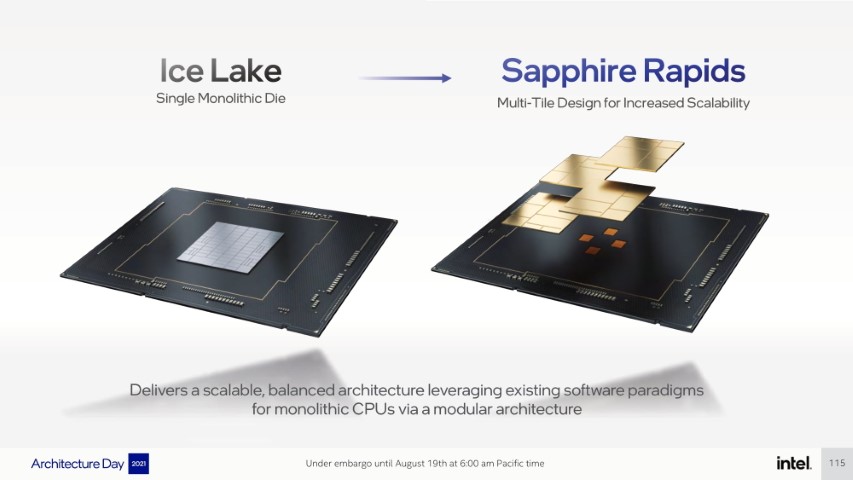YuuKi AnS, a Twitter user, has provided a number of
screenshots revealing information on Intel's upcoming Sapphire Rapids-SP
56-core processor. We like to get a sneak glance at the chip's specifications
even if there aren't any benchmarks.
Sapphire Rapids, like Intel's rumoured Alder Lake processors, can include
Golden Cove cores and Intel's seventh node, formerly known as the 10nm
increased SuperFin technique. The Sapphire Rapids-SP CPU has 56 cores and 112
threads, according to the source. On paper, AMD's EPYC 7003 (Milan) CPUs have
up to 64 cores and 128 threads, so it's uninspiring. However, it will be
fascinating to see Golden Cove take on Zen three in the knowledge centre house.
In addition, the Intel processor features 112MB of L2 cache and 105MB of L3 cache. The EPYC 7003 features up to 256MB of L3 cache in its top layer. Intel is also offering Sapphire Rapids with up to 64GB of HBM2e memory, while AMD has equipped its Milan-X processors with 512MB of 3D V-Cache.
Also Read: 7-Zip App Vulnerability due to a significant security flaw in your Computer April 2022
Because the Sapphire Rapids-SP processor from YuuKi-AnS
is an engineering sample (ES), the clock rates should not be taken seriously.
The 56-core half has a base clock of one.9 gigacycles per second and a boost
clock of three.3 gigacycles per second so far. According to the report, the
single-core boost speed increases to 3.07 GHz.
On Intel's C741 (Emmitsburg) platform, the Sapphire Rapids-SP processor (ES2
QYFS) had 1TB of DDR5 memory with CL40-39-38-76 timings. The processor was
installed on a Socket E (LGA4677) motherboard.
If the knowledge is right, the CPU has a 350W PL1 rating and a 420W PL2 rating. The BIOS-enforced power limit, on the other hand, is a whopping 764W. The flagship Milan SKU, the EPYC Milan 7763, has a 280W TDP. The Twitter user did not specify the type of cooling used by the Sapphire Rapids-SP processor. The Sapphire Rapids-SP chip, on the other hand, hit a ninety-nine degree temperature, according to the research.
Sapphire Rapids was supposed to start in the second quarter of this year, but delays have pushed it into the third. Because AMD's EPYC 7004 (Genoa) series is expected to debut around the same time, this will be a huge disadvantage for Intel. Unlike Milan, Genoa will be able to take advantage of TSMC's revolutionary 5nm process node and AMD's Zen four cores. Genoa will increase the number of cores in EPYC processors from 64 to 96, allowing Sapphire Rapids to create a 96-core, 192-thread monster. As a result, Sapphire Rapids may find itself with a lot on its plate.
MAJOR UPDATE:
Yuuki Ans has now benchmarked the same Intel Sapphire Rapids-SP ES CPU against Intel's Cascade Lake Xeon 8280L (8S Config), Ice Lake Xeon 8380 (2S Config), EPYC 7763 (2P config), and EPYC 7773X processors (2P config). The Sapphire Rapids-SP CPUs were also configured with 64 GB of DDR5-4800 memory in a dual-socket configuration. The rest of the platforms were running DDR4 platforms with the highest specifications that the platforms could support.
In terms of benchmarks, The Intel Sapphire Rapids-SP CPU outperformed the Ice Lake-SP chips in single-core performance, but AMD's EPYC Milan components won four out of six test. The CPU could only equal the Zen 3 server chips on 1T CPU benches, despite the new Golden Cove architecture. The AMD EPYC Milan range completely demolished the Intel Sapphire Rapids-SP CPUs in multi-threaded benchmarks. For the sake of comparison, the AMD EPYC Milan CPU outperformed the undisclosed Intel chip by up to 2.3x in CPU-z.
Also Read: Asus ROG Flow Z13 Review A detachable 2-in-1 gaming Laptop
Surprisingly, the CPU performs significantly better in the CPU-z AVX-512 tests, but we know that AVX-512 consumes a lot more power, which could push the power statistics closer to the 700-750W BIOS limit. Because of the focus on each individual core, the AVX-512 clock speeds are rated substantially lower. Intel has previously utilised AVX-512 to inflate benchmark statistics, and while the technology is effective in some HPC tasks, it isn't commonly used, so non-AVX-512 applications will benefit more from ordinary core computing performance.
Although it's an ES chip, and we expect the Sapphire Rapids-SP chip to perform substantially better in the QS stage, the final chip may only be competitive with AMD's EPYC Milancomponents, given that it will be released at the same time as AMD's next-generation EPYC Genoa 7004 CPUs. With such a high power drain and insufficient performance, it appears like Intel will continue to lose ground to AMD in the server market, as it has done for the past few generations.










0 Comments